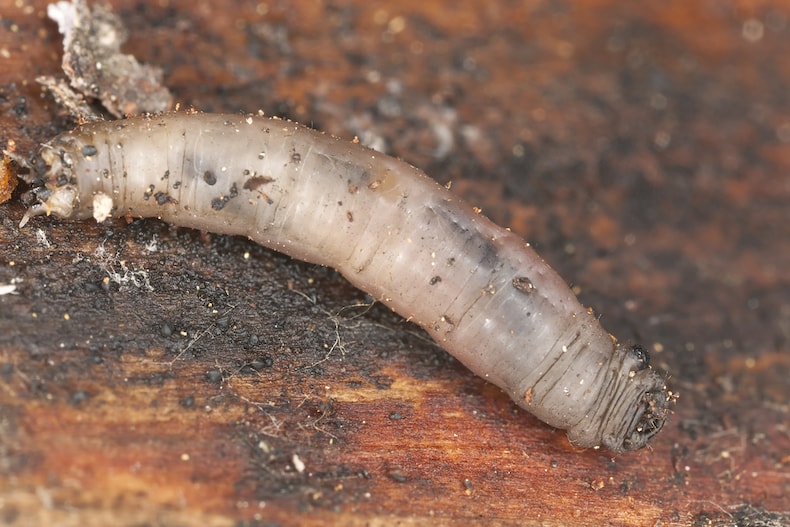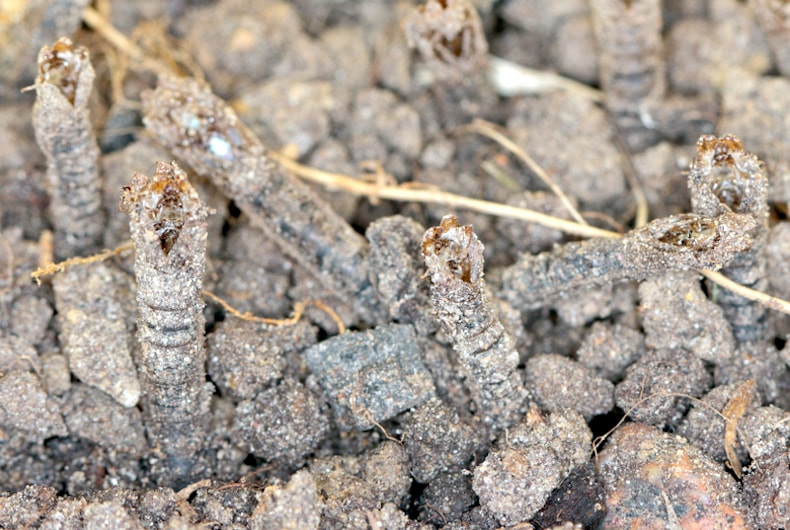Garden pests - Leatherjackets

Leatherjackets are the larvae of crane-flies
Image: Henrik Larsson/Shutterstock
If your lawn is looking a bit sorry for itself, you may have a leatherjacket problem. Read on to find out how to deal with these garden pests.
What are leatherjackets?
Leatherjackets are the soil-dwelling larvae of crane-fly (daddy long legs). They’re around 30mm long, with greyish-brown bodies and no legs.
They grow underneath lawns, feeding on grass roots until they pupate and emerge as crane flies between August and October, and lay the next generation of leatherjackets.
Leatherjackets do better in damp conditions, so there are often more of them after a wet autumn. They will overwinter in cold winters, but if there’s a mild winter, the larvae will carry on feeding throughout the year - causing more damage.
How can I recognise leatherjacket damage?

Keep an eye out for empty pupal cases on your lawn
Image: Tomasz Klejdysz/Shutterstock
It’s not hard to spot leatherjacket damage. If you have leatherjackets in your garden, you’re likely to notice the following signs:
- Yellow-brown dead patches in your lawn.
- Leatherjackets in the surface layers of the soil under your lawn.
- Empty pupal cases sticking up above the lawn surface as adult crane flies emerge in the summer.
- Small, round holes in your lawn caused by birds (crows, magpies, rooks and starlings) hunting around for leatherjackets.
- Seedlings and small plants dying in flower beds and vegetable plots because leatherjackets have damaged the stems at ground level.
What plants do leatherjackets eat?
Leatherjackets feed mainly on lawn grasses but sometimes also eat seedlings and small plants.
What is the best way to control leatherjackets?

Trapping leatherjackets is one way to control an infestation
Image: Shutterstock
Damage prevention is all about controlling the environment.
There are no chemical controls you can use to eliminate leatherjackets from your garden. However, there are some biological and organic methods that are very effective:
- Look after your lawn - paying special attention to the condition of your lawn and encouraging vigorous growth will help to fortify it against any damage caused by leatherjackets.
- Introduce nematodes - the most effective way to kill leatherjackets is by watering the pathogenic nematode Steinerema feltiae into your turf in the autumn. These nematodes need moisture to survive so water your lawn before and after you introduce them.
- Trap them - here’s how to lure leatherjackets to the surface of your lawn so that you can harvest and remove them from your garden. Pick a warm night in early summer after it has rained. Cover your lawn with black polythene that completely blocks the light. Any leatherjackets will come to the surface and you can collect them the following morning.
- Encourage birds - many wild bird species (particularly corvids) love eating leatherjackets, so encourage these into your garden. Beware, though, this can leave holes in your lawn from digging! Chickens are also an effective leatherjacket predator - although they will do a lot of damage to your lawn in their hunt for these grubs.
Other pages you might like
- Pest & Disease Control Products
- Lawn care advice and resources
- Gardening for beginners
- How To Gardening Guides







